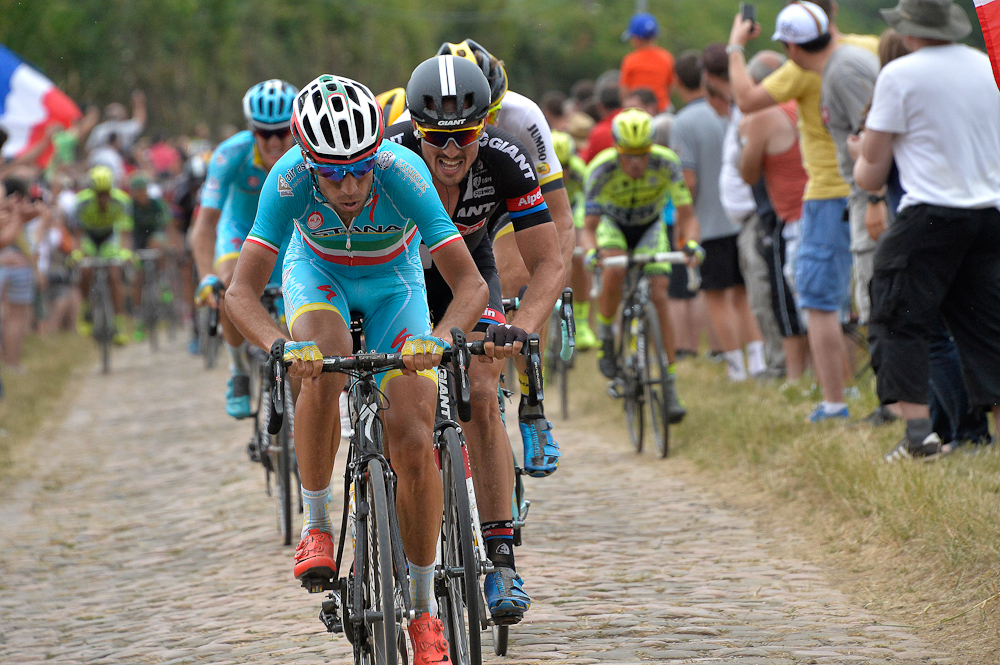Nibali unable to conjure up repeat result on Tour de France cobbles
'Froome is the strongest right now,' says Martinelli





No man, according to the Greek philosopher Heraclitus, steps in the same river twice, and what rang true 2,500 years ago in Ephesus also holds water for the Tour de France.
Astana selects strong squad to back Nibali at Tour de France
Tour de France quotes: Martin melts, Nibali and Mollema happy after Utrecht time trial
Tour de France: Nibali makes early gains in Utrecht time trial
Tour de France time loss due to bad luck not bad legs, says Nibali
Tour de France: Froome hails 'huge advantage' over Nibali and Quintana after crosswinds
Twelve months ago, when the race visited the cobblestones of northern France, Vincenzo Nibali waded his way decisively towards overall victory by putting significant time into all of his principal rivals following a powerful collective showing from his Astana team.
It was hardly surprising, then, that Astana adopted a strikingly similar playbook this time around, even to the point of again sending Lieuwe Westra up the road in the early break on stage 4 to Cambrai. Later, Nibali and his teammates hit the front repeatedly on the six final cobbled sectors in a bid to place Chris Froome (Sky), Alberto Contador (Tinkoff-Saxo) and Nairo Quintana (Movistar) into difficulty, but without the same success as a year ago.
Although Contador and Quintana, in particular, were occasionally on the back foot, the day ended with no change among the Big Four of favourites, who all finished the day in the chasing group, three seconds down on stage winner and new maillot jaune Tony Martin (Etixx-QuickStep).
Standing by the Astana team bus afterwards, directeur sportif Giuseppe Martinelli told Cyclingnews that from the very outset, he sensed that Nibali would struggle to repeat his gains of a year ago, simply because of the different circumstances of the day.
“I think all of the teams were a bit better prepared compared to last year, the cobbles weren’t as difficult as last year and the good weather changed everything too,” Martinelli said. “If you don’t have luck on your side, not a lot can happen in a situation like that. Lars Boom punctured on the second section of cobbles, too, and we lost an important man. In the end, the main thing was that nothing happened to Vincenzo.”
Nibali did come away from the pavé with the consolation of being adjudged the day’s most combative rider but his deficit to Froome in the general classification remains at 1:38, while he trails Contador by 1:01. The day’s stage was surely one he had earmarked to recoup the ground he lost when the race split into echelons on Sunday, though he kept any disappointment in check in the mixed zone afterwards.
The latest race content, interviews, features, reviews and expert buying guides, direct to your inbox!
“We rode well and tried to make a few attacks to try and repeat what we did last year, but maybe last year was just that bit more harder because of the rain,” Nibali said. “There’s a gap to make up on Alberto and Froome, but we’ll see day after day and if there’s a chance for us to attack, we’ll try to take it.”
On the final sector of pavé, the elastic to Contador and Quintana did snap temporarily and they were each distanced when Nibali and Froome traded blows at the head of a select leading group, but the danger was snuffed out soon afterwards.
“I’d made a strong attack then Froome made another violent acceleration so we were all a bit flat-out and there was a headwind, so it wasn’t easy to inject a bit more momentum into the attack,” Nibali said. “And in any case Saxo were pulling hard behind and they managed to stitch back the gap. It was a strong attack but Valverde was there, and he wasn’t interested in riding with Quintana behind either.”
Rather unexpectedly, given his travails on the equivalent stage last year – albeit ahead of the opening sector of pavé – Froome was by some distance the most pro-active of Nibali’s three main rivals on the cobblestones, though the Sicilian insisted that he was not altogether surprised by the Sky man’s display.
“We know with Froome that when he’s good he can go at 110 per cent, as we’ve seen in the past, so it’s normal that he can go on the attack even on the pavé,” he said. “But in the end, Joaquim Rodriguez performed well too, so all of the GC riders came out of it pretty well.”
For the second successive day, and on radically different terrain to the Mur de Huy, Froome delivered a startling show of force, enough to persuade Martinelli to revise his thinking on the hierarchy of Nibali’s rivals for overall victory.
“He was strong yesterday and maybe even stronger today. I thought before that Quintana was the man to beat, but now Froome is really the strongest at this moment,” Martinelli said. “Right now he’s certainly the strongest.”
Among the many variants and interpretations of Heraclitus’ maxim to pass into posterity, incidentally, is one that reads: “No man steps in the same river twice for it's not the same river and he's not the same man.” One senses that Nibali may well need to be at least the same, if not better, to repeat his 2014 triumph.

Barry Ryan was Head of Features at Cyclingnews. He has covered professional cycling since 2010, reporting from the Tour de France, Giro d’Italia and events from Argentina to Japan. His writing has appeared in The Independent, Procycling and Cycling Plus. He is the author of The Ascent: Sean Kelly, Stephen Roche and the Rise of Irish Cycling’s Golden Generation, published by Gill Books.